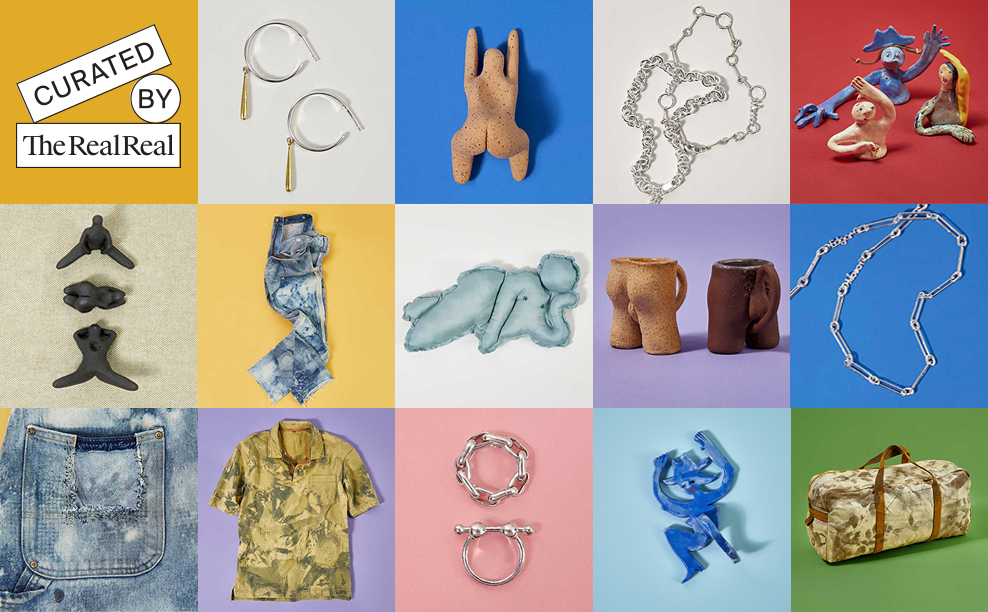
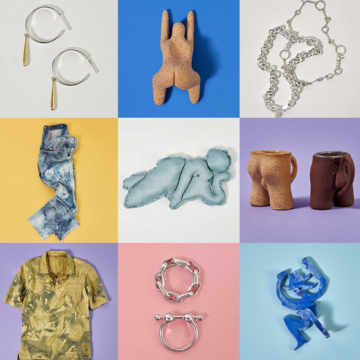
The Love Is Real
This Pride month, The RealReal is highlighting the work of queer makers and artisans through a specially curated sale of art, accessories, and more with a portion of proceeds donated to the Marsha P. Johnson Institute.
Curated by The RealReal is an edit of exceptional, one-of-a-kind pieces that are hand-picked by our team of editors and curators. It’s about an eye for what’s good, what will stand the test of time, and the magic of the mix. “The four creatives we are partnering with for this Pride campaign share an artistic pursuit to recontexualize (and celebrate) the queer body,” says Alex Tudela, TRR’s Home & Art Editorial Manager.
Here, our collaborators—Alex Schmidt, Anjelica Alubowicz of Alubowicz, Edgar Mosa, and Amy Giovanna Rinaldi of Intimate Revolution—share their process, how their identity informs their work, and what you can do to support the LGBTQIA+ community today.
Alex Schmidt
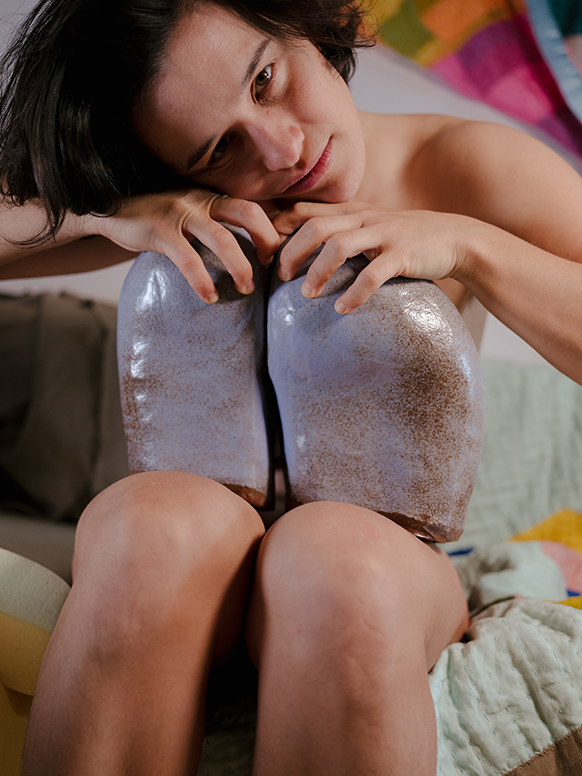 Photograph by Dan McMahon.
Photograph by Dan McMahon.
A Brooklyn-based artist, comedian, and educator, Alex Schmidt works under the name “Body Confidence.” Their work focuses on body and sex positivity.
Describe your work as an artist/maker.
I am a sculptrex, figure model, and community organizer seeking to leave traces of care wherever I play. The many wigs of my practice are woven together like a quilt—sculptures are informed by childhood, queerness, and athletics.
What’s your artistic process?
I primarily work improvisationally, usually inspired by an idea that bubbles around in my mind. I love taking notes in the shower. I made many of these charms in the front yard of my house. I write the poems that accompany the Chosen Family charms anywhere + everywhere—before bed, on the train, at my desk—and later type them out on a typewriter.

What inspires you and your work?
I come from a family with a history of autism and have been working in early childhood education for a decade. I am hugely inspired by transitional objects and soothing tools (like weighted and baby blankets) that can help ground us—children and adults alike—in our bodies.
How does your identity influence what you create?
I felt a lot of shame about my queerness and my queer body for a very long time—the person I long thought was deeply undesirable was actually just a buff, long-haired butch who would love and be loved so deeply! My sculptures and my practice respond with humor, shamelessness, and care.
My queerness also informs my desire to create work that prioritizes collective care, because my ability to live freely as a queer womxn is indebted to those that fought before me.
What does Pride month mean to you?
To be honest, I feel *quite* complicated about Pride Month (understatement of le century?) It’s unnerving to see huge companies appropriating and profiting off of queer and trans culture without giving back in material ways, and that the Stonewall Uprising (which was in direct response to anti-gay police raids) is now celebrated with a hugely policed parade.
I’m super grateful for Dyke March and Queer Liberation March, two actions that understand that there is no Pride without justice for all. Pride month is a time when we reflect on how we can take pleasure in our queerness while fighting for those in our community who are still in danger.
What are some ways anyone can support the LGTBQ+ community?
I think that some of the biggest impacts we can make are daily, (often invisible) gestures.
– If your workplace is hiring, encourage queer and trans people to apply and put in a good word for them.
– Advocate for fair compensation for queer artists and creatives
– Help your family get comfortable with affirmative pronouns and identifiers (and learn that it’s okay to get it wrong sometimes, just say “thank you for correcting me” and move on).
– Learn how to talk to children in queer-inclusive ways. Children get it and have a lot to teach you.
– Support the last few remaining dyke bars in the US!
– For everyone who has the means: send money to Black trans womxn directly.
How do you see Pride extending beyond the month of June?
I believe time is a construct, and love celebrating my queerness as often as I possibly can. The biggest impacts we can make are the ones we make throughout our lifetimes, in the hopes that our small gestures will serve generations to come. June is just a month; fighting for and creating queer community is forever. I love wearing my GAY shirts in the airport, so I can flag my queerness at all the hot TSA agents.
What are you looking forward to this summer?
I’m really so excited to play with friends I’ve met through Dyke Soccer, swim in the ocean with my partner, and spend as much time as possible resting with my puppy Merlin. I want to read some yummy things, play with clay in my studio, and discover opportunities to figure-model in person again.
Why is supporting the Marsha P. Johnson Institute important to you?
There is no Pride without activists like Marsha P. Johnson, who was a prominent figure of the 1969 Stonewall Uprising. Marsha P. Johnson was a self-identified drag queen, performer, and survivor, and was, like so many Black trans womxn, lost too soon.
If we are to celebrate Pride month, we must do so alongside recognition of the violence, homelessness, incarceration, and poverty that continues to impact Black trans womxn disproportionately in the US.. Visibility without material support is insufficient.
Alubowicz
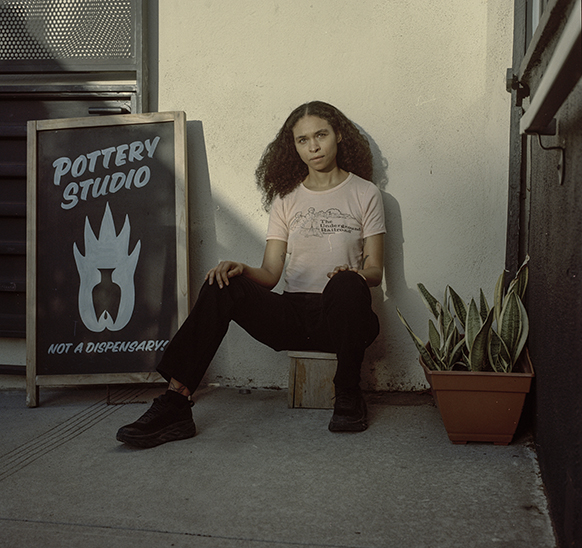
Created by Anjelica Alubowicz, an L.A.-based artist who handcrafts her clay and fabric pieces in functional, body-centric forms that are inspired by her Black and immigrant roots.
What’s your artistic process? How are your pieces made?
My ceramic pieces are all sculpted by hand, which I’d like to think gives them a more human feel. They’re pretty tongue-in-cheek so I try to set light and positive intentions while forming each piece.
The soft sculptures are made using fabric remnants and pieces of altered or damaged garments. They’re sewn with my home sewing machine and the embellishments are hand stitched.
I try to make everything functional because I believe, even though something doesn’t solely serve a decorative purpose, it doesn’t mean it isn’t art. Also, who doesn’t love a two-for-one deal?
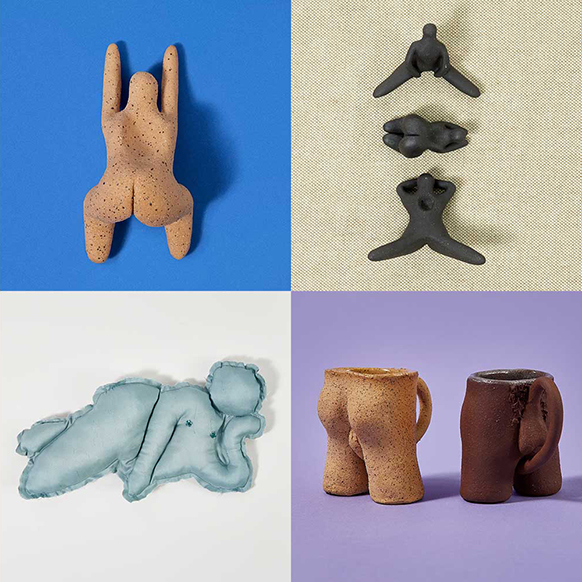
What inspires you and your work?
I’m inspired by the beauty and imperfections in nature and by all things funny, macabre, strange, sensual, and/or quiet.
How does your identity influence what you create?
To me, queerness is finding beauty where one’s told not to. So if we’re looking at what society deems not beautiful or appropriate, there’s an endless well of inspiration and influence to pull from.
What are some ways anyone can support the LGBTQ+ community?
Buy from queer makers, experience queer art, listen and learn from queer stories, donate to queer organizations that queer activists co-sign.
Why is supporting the Marsha P. Johnson Institute important to you?
The Marsha P. Johnson Institute is led by and centers Black trans people, while prioritizing the most underserved intersections of their community. Because of this, those getting direct aid from the organization have a much greater chance of being more thoroughly understood and cared for.
Edgar Mosa
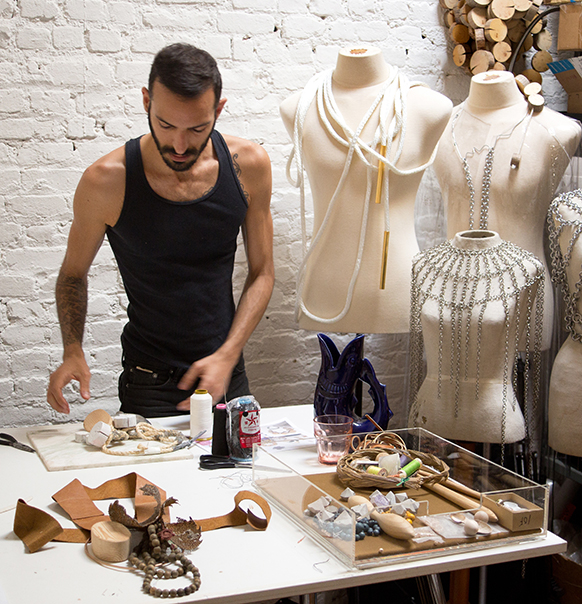
Originally from Lisbon, Portugal, Edgar Mosa is a jewelry designer and formally-trained goldsmith. His witty and playful designs, made of ethically-source materials, are reflections of his own identity and queer culture.
Describe your work as an artist/maker.
Every piece brings a bit of biting wit, a healthy serving of sex, and a rare level of craft.
What’s your artistic process? How are your pieces made?
Everything starts with my hands. I’ve been doing this since I trained in goldsmithing as a teenager in Portugal. This skill is my superpower.
I make every single thing myself at my jewelry bench which is just a few steps away from my bed. I wear every piece before it goes to the customer. I want to make sure that they are functional and meet my standards. Everything has my personal handwriting all over it. This means I can experiment while always keeping a signature bit of Edgarness.
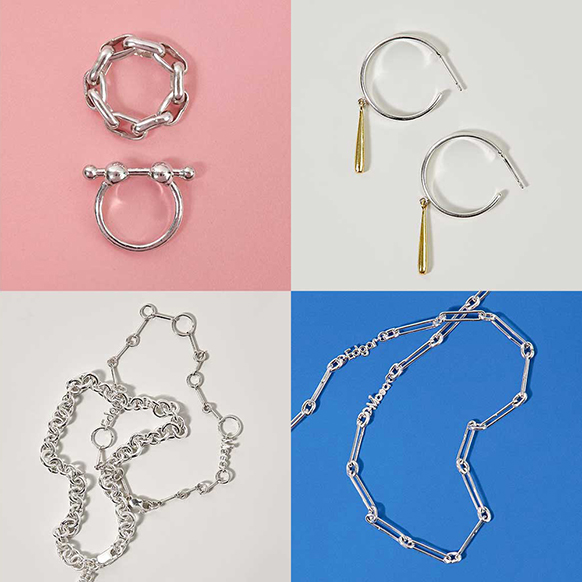
What inspires you and your work?
Play. I sit down at my bench with my materials laid out in front of me and it all comes to life. There’s so much potential in just tools, fire, metal, and jewels. I always find something new to do with them.
How does queer identity influence what you create?
My community is my work. My work is my community. These pieces wouldn’t mean nearly as much if people I love and respect weren’t wearing them.
Who are some other artists/creatives that you admire?
Ivy Haldeman’s meticulousness; Doron Langberg’s fluid talent; Ryan Burke’s boundless creativity.
What does Pride month mean to you?
Pride is so powerful because it’s us saying, “here we are, look at us.” When you confront people with the fundamental truth that queer people exist and aren’t going anywhere, it makes us powerful. I want people to feel that power when they wear my jewelry. By wearing something beautiful and conspicuous, you’re claiming space and demanding to be seen.
What are some ways anyone can support the LGTBQ+ community?
Just listen. We have so many stories to tell. And those stories were silenced for way too long. We have to make up for lost time.
How do you see Pride extending beyond the month of June?
Pride month is a great time to party and remember, but the work that we’re doing needs attention all year round. Our trans family especially is under threat right now. It’s not going to end when the parades are over. The only way we’re going to make progress is with sustained pressure and work. I want all the companies that are benefiting from the Pride bandwagon to set a calendar reminder for July 1st to look around them and say, “okay, what do we do now?” And we as the queer community have to check in and hold them accountable, too.
Why is supporting the Marsha P. Johnson Institute important to you?
Marsha P. Johnson is one of our greatest icons. Probably more than any other individual, she stands for and had a hand in creating everything we love about Pride. Being associated with and contributing to her legacy is an honor in and of itself.
Intimate Revolution
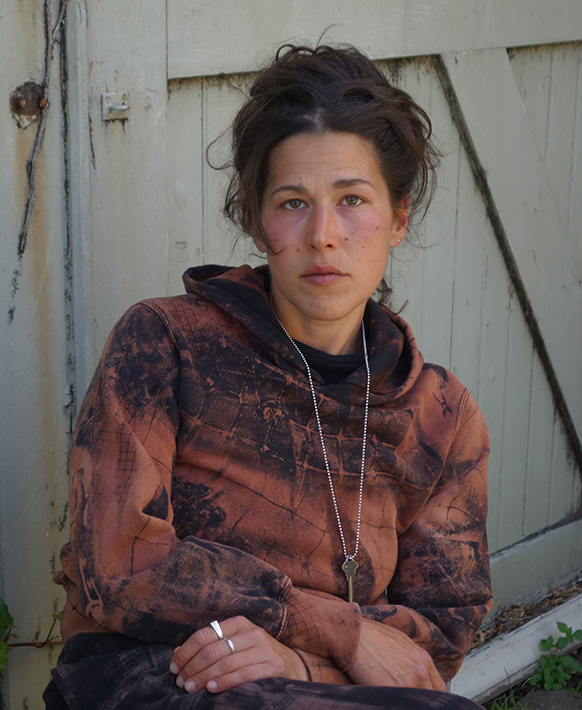
Created by sculptor and printmaker Amy Giovanna Rinaldi, who began making “Queer Camo”—a line of wearbale art objects—as a response to the political landscape of the past year. Using alternative printmaking techniques, reclaimed materials, and developed dyes she makes one-of-a-kind, unisex pieces.
Describe your work as an artist/maker.
My work has often been inspired by the relationship of trauma expressed on and through the body. It aims to reconcile—to understand—these fracturing moments that I myself feel so alienated by.
What’s your artistic process? How are your pieces made?
The clothing is made through an addition and subtraction process—much like how one often works in traditional printmaking. Textiles are dyed, stripped, over dyed, stripped again. I have developed a process of “weight printing” the pieces, which essentially means that pressure is put on a 3D object – and with pressure, time, heat, ice, salt, etc – the object’s form holds dye that sits on different layers in the fiber of the cloth. When you look at some of the weight prints the images look almost photographic.
The development of this process has allowed the fragility, density and form of the original object to be forever imprinted in the fiber. Like past trauma, strength gained, tools acquired to cope—these objects become part of armor, a skin—a part of housing a body in all its forms: ‘Queer Camo’.
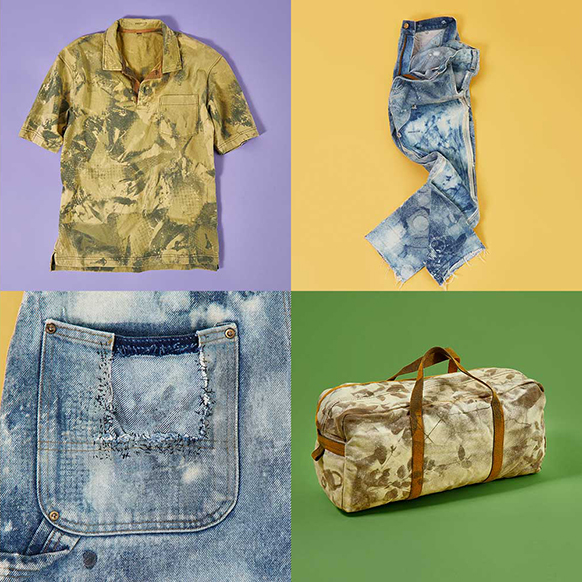
How does your identity influence what you create?
When I am honest with myself perhaps the studio “came out” before I could. I was already exploring my body, my desire, my fear in objects long before I could confront them head on in my life. As the work progressed, the studio changed, objects became more honest—I became more honest and now it feels almost impossible to divorce the two. I am the maker of the work. The work is Queer.
What does Pride month mean to you?
As for how I respond to Pride—like many Queer people my relationship to it has been complex. I grew up in the Bay Area thinking, as a child, that Pride was like St. Patrick’s Day or the 4th of July—a celebration of difference that ‘the whole world’ experienced. Now, as an adult, Pride holds a history, a pain, a celebration that I am only beginning to understand the magnitude of. I have an anger for a past that I was not born into. This history has taught me that I am allowed to be afraid but with this privilege I am not allowed to be silent. My voice is my Pride.
What are some ways anyone can support the LGTBQ+ community?
If everyone who held the belief that human beings are valuable and equal stood up and said “We are here”, if every straight person in line at the grocery store said something—did something—when they saw a queer person hassled, treated differently, blown off. If we start to normalize compassion and equality, start to stand up for human beings and not a gender, orientation, sex—there are more people on this team than we think.
Shop the artists’ pieces and more from Curated by The RealReal now.

